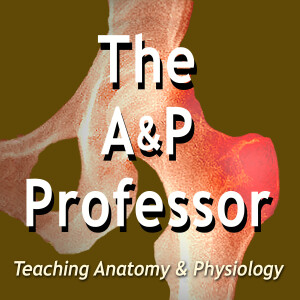
The Wallenda Model of Homeostasis | Episode 46
 2019-06-17
2019-06-17
00:44 | Measles & Immune Amnesia
09:16| Sponsored by HAPS
09:44 | Bone Growth Update
13:55 | Sponsored by AAA
14:27 | Featured: The Wallenda Model of Homeostasis
40:43 | Sponsored by HAPI Online Graduate Program
41:32 | Hearing from YOU
If you cannot see or activate the audio player click here.
Questions & Feedback: 1-833-LION-DEN (1-833-546-6336)
Follow The A&P Professor on Twitter, Facebook, Blogger, Nuzzel, Tumblr, or Instagram!
After nourishment, shelter, and companionship, stories are the thing we need most in the world. (Philip Pullman)
1 | Measles and Immune Amnesia
8.5 minutes
Measles (MV) is very contagious and can be deadly, even though some cases are mild to moderate. However, it can also "erase" some or all of our immune memory!
Measles and Immune Amnesia (article from American Society for Microbiology) my-ap.us/2F0Chew Watch: The tricks that make measles so infectious (video you can use in your class) my-ap.us/2EWugar 2 | Sponsored by HAPS0.5 minutes
The Human Anatomy & Physiology Society (HAPS) is a sponsor of this podcast. You can help appreciate their support by clicking the link below and checking out the many resources and benefits found there. AND mention your appreciation to the HAPS leadership while you are at the conference—or anytime that you communicate with them.
Anatomy & Physiology Society
theAPprofessor.org/haps
3 | Bone Growth Update
4 minutes
How we understand growth of a long bone at the epiphyseal plate may be changing a bit. Check out the audio and the links below to find out more.
New mechanism of bone growth discovered (summary article) my-ap.us/2EYEdEc A radical switch in clonality reveals a stem cell niche in the epiphyseal growth plate. (journal article in Nature) my-ap.us/2F2cwKy
4 | Sponsored by AAA
0.5 minute
The searchable transcript for this episode, as well as the captioned audiogram of this episode, are sponsored by The American Association of Anatomists (AAA) at anatomy.org. Their big meeting is in April at the Experimental Biology (EB) meeting in Orlando FL. Check it out!
Searchable transcript Captioned audiogram
5 | The Wallenda Model of Homeostasis
26 minutes
Multiple models of homeostasis may be needed for students to fully understand the important core concept of homeostasis. Here, Kevin describes an analogy he uses—a person on a highwire. Listen to why he calls this model The Wallenda Model and find out how he uses it to better understand homeostasis.
The Wallendas are a family of highwire artists famous for very high/long "sky walks" and human pyramids on the wire Karl Wallenda, the most famous of the clan, died from a fall off the wire during a sky walk The famous 7-person pyramid was also marred by a tragic fall Elements of The Wallenda Model Variable: position of body Set point: directly over the wire Sensors: nerve receptors (eyes, inner ears, muscle stretch receptors, etc.) Integrator: brain Effectors: skeletal muscles Where to send students: lionden.com/homeostasis.htm A summary of all three models Kevin uses to teach homeostasis Includes photos and links to videos Survival Guide for Anatomy & Physiology lionden.com/tips-survival-guide.htm Includes a short, illustrated summary of The Wallenda Model of Homeostasis
6 | Sponsored by HAPI Online Graduate Program
0.5 minute
The Master of Science in Human Anatomy & Physiology Instruction—the MS-HAPI—is graduate program for A&P teachers. A combination of science courses (enough to qualify you to teach at the college level) and courses in instructional practice, this program helps you power up your teaching. Kevin Patton is a faculty member in this program. Check it out!
nycc.edu/hapi
If the hyperlinks here are not active, go to TAPPradio.org to find the episode page.
More details at the episode page. Transcript available at the script page. Listen to any episode on your Alexa device. Need help accessing resources locked behind a paywall? Check out this advice from Episode 32 to get what you need! https://youtu.be/JU_l76JGwVw?t=440
More Episodes
Create your
podcast in
minutes
- Full-featured podcast site
- Unlimited storage and bandwidth
- Comprehensive podcast stats
- Distribute to Apple Podcasts, Spotify, and more
- Make money with your podcast
It is Free
- Privacy Policy
- Cookie Policy
- Terms of Use
- Consent Preferences
- Copyright © 2015-2024 Podbean.com






